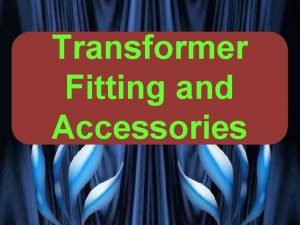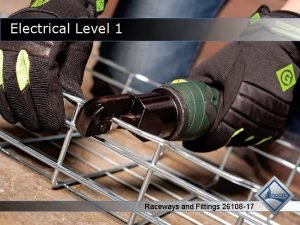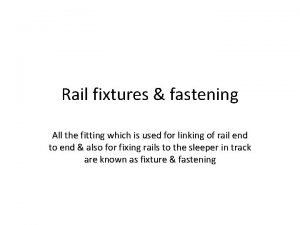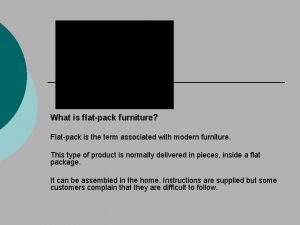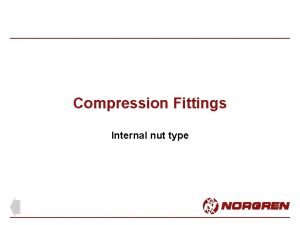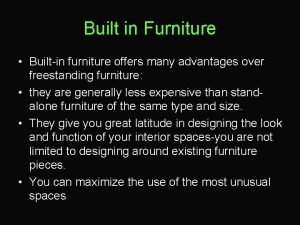Flatpack furniture Knockdown fittings Flatpack furniture is now










- Slides: 10

Flat-pack furniture & Knock-down fittings

Flat-pack furniture is now common place and allows the buyer to assemble the product at home. As expected from the name, furniture is purchased dismantled in several pieces which are packed flat in a box. Flat-pack furniture has a number of advantages for the manufacturer as they can: - Transport more of the item due to it being flat. Reduce the cost of manufacture because they do not need to assemble it. Improve sustainability due to reduced transport and manufacturing processes. - Knock-down fittings can be bought cheaply in bulk, which is less expensive than manufacturing wood joints. Flat-pack furniture also has a number of advantages for the consumer as: - Costs are reduced due to reduction of manufacturing processes. - The readiness of off-the-shelf furniture can be fitted into your car for transport home, meaning no delivery fees.

Flat-pack furniture Assembly instructions are provided with all flat pack furniture. You may have seen instructions like this if you’ve ever bought furniture from IKEA. Often, assembly instructions will be in the form of a picture storyboard, which is significantly easier to understand than written instructions. This also means that instructions can be used worldwide and do not need to be translated into multiple languages, saving the company money. Knock-down fittings are provided with the flat-pack furniture and manufacturers may also include basic tools like small spanners or Allen keys. Instructions will also state what other basic household tools you might need for assembly such as a screwdriver or hammer.

Knock-down fittings are those that can be put together easily, normally using only a screw driver, a drill, a mallet/hammer and other basic tools such as an Allen key. They are temporary joints although many are used to permanently join together items such as cabinets and other pieces of furniture that are purchased in a flat pack.

Modesty Blocks The modesty block is a one-piece plastic block which is pressed against the two pieces of material (normally wood based). Screws are used to fix the block into position. This type of joint is used to fit modern cabinets such as those found in a kitchen. It is a relatively strong joint although it has the advantage that it can be dismantled using a screwdriver. Natural Wood Fitting This works in the same way as a modesty block but is made from a small square wooden batten instead of plastic. A piece of material such as pine can be drilled and screws can be passed through these holes. This gives a cheap and effective knock-down joint. The screws are normally countersunk into the knock-down fitting.

Two Block Fitting These are also known as Bloc-joints. These are made from plastic. The two halves of the fitting are fixed to both pieces of the wood. A bolt passes through the first fitting into the thread of the second. As the bolt is tightened it draws the two fittings together. The pins help keep the fitting straight. This gives a very strong joint and it can be dismantled using a screwdriver.

Rigid Joint These are normally moulded in plastic which makes them strong. Screws pass through the four holes which hold the sides at each corner firmly together – two into the vertical side, and two into the horizontal side.

Cross Dowel Fittings These fittings are also referred to as scan fittings and are strong enough to be either permanent or temporary joints. The cylinder (known as a cross-dowel) is inserted into the first side of a cabinet in a predrilled hole. A screw or bolt is then pushed through the hole in the second side until it meets the cylinder. It can then be tightened with a screw driver, spanner or Allen key until both sides of the cabinet pull together. A washer is often used to prevent the screw or bolt from damaging the wood.

CAM Locks The disk fits into a recess in the first side of the cabinet. It rotates by inserting a screwdriver into the slot in its side. The shaft is screwed into the second side of the cabinet. The collar of the shaft is passed through the hole in the second slot in the disk. When the disk rotates the shaft is locked in position. This keeps both sides of the cabinet locked together.

Table plate fitting The ‘table plate’ fitting (also known as a leg fastening) is ideal for chairs or tables because it can be set up quite easily with the use of a spanner and a screw driver. The highlighted area shows how the parts fit together, using a table plate. The hanger bolt remains in the leg, and the nut is unscrewed to take the leg off.





